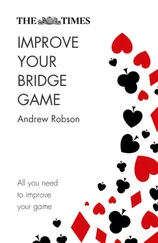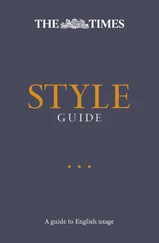
(b) Opener bids 1♠. Again responder knows there’s a spade fit (opener must have four+ spades, and responder has four spades, so the partnership has eight+ spades). However responder has a relatively low point count, so should raise to 2♠. This conveys to opener that responder supports spades as trumps but her hand is only worth a minimum bid. With nothing to add to his opening bid, opener then passes. They’ve found their fit but lack the strength for game. The bidding sequence is:
(c) Opener bids 1♠, which doesn’t reveal a fit to responder. She therefore tries her favourite (longest) suit at the lowest level possible, bidding 2♣. This suit doesn’t appeal to opener, but rather than repeat spades he offers a third choice of trump suit, hearts. Responder now knows they’ve found their fit (the partnership has at least eight hearts). She considers whether the values for game are present: she has 13 points, and her partner has advertised 12+ by opening, which is enough to bid a game contract (25 points are needed to go for game). Responder jumps to 4♥. The bidding sequence is:
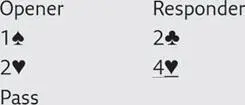
must know
Don’t bid unnecessarily high when bidding a new suit. Try to find a fit as ‘cheaply’ as possible i.e. the bid you reach first as you work up the bidding ladder on p. 22(the bid that requires the least number of tricks to make a contract). Then assess whether or not you have enough points to go for game.
Responding to a 1NT opener
If your partner opens the bidding 1NT, as responder you should be happy because he’s described his hand very accurately: 12, 13 or 14 points and one of three balanced distributions (see the diagrams on p. 26). In most cases you’ll be in a position to place the final contract.
Strategy for responding to 1NT opener
Remember that opener will only rarely bid again, so you should assume (at this stage) that your bid as responder will end the auction.
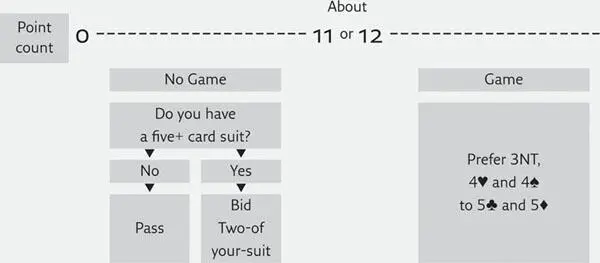
Now consider how you’d respond to your partner’s 1NT opener when you hold the following cards:
(a) You know the partnership has enough strength for game (you have 25 or more points between you). With your balanced hand, your preferred bid is 3NT.
(b) You know the values for game are present. You also know there’s a heart fit (a 1NT opener can’t contain a void or a singleton so your partner must have at least two hearts, which makes at least eight hearts between you). The correct response is jump to 4♥.
(c) With such a weak hand there’s clearly no chance of going for game. However, leaving your partner in 1NT would be a mistake so you need to make a bid. Your hand is useless in no-trumps but may take a few tricks with diamonds as trumps, so bid 2♦. Your bid effectively removes your partner’s 1NT bid and is known as a ‘weakness take-out’. Your partner will know not to bid again (he’ll look on your bid as a rescue).
must know
• When your partner opens 1NT, as responder you must consider whether to make a trump suit or to stay in no-trumps, and whether to go for game.
• Responding Two-of-a-suit removes your partner’s 1NT opener and is known as a ‘weakness take-out’.
Responding to a suit opener
If your partner opens with One-of-a-suit, e.g. 1♥, you know that 19 is the highest point count they can have to open at this One level (see diagrams on pp. 29and 30). This means that you, as responder, need a minimum of six points to have a chance of game (25 points in total are required for game).
Strategy for responding to One-of-a-suit opener
If you as responder have six+ points in total then you should keep the bidding open (note the difference between this and responding to 1NT, where the opener’s upper limit is 14 points).
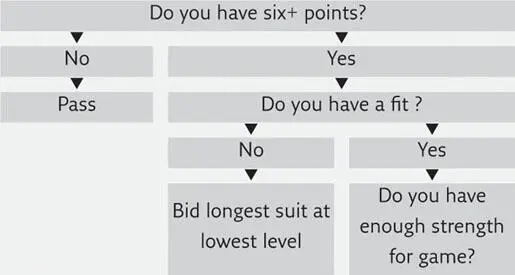
Now consider how you should respond to your partner’s 1♥opener if you hold the following cards:
(a) You have fewer than six points. The partnership doesn’t hold the 25 points for game, so you should pass. To bid would show (inaccurately) six+ points.
(b) You have plenty of points to respond, plus a fit for hearts. Also, the point count is high enough to go for game (13+12 = 25). You should jump to 4♥.
(c) You easily have enough points to bid, but no guarantee of a fit for hearts (opener may only have four hearts, in which case you’d need four to make the eight required for a fit). Instead you should bid your longest suit at the lowest level, and await developments: a bid of 1♠. This shows you have at least six points in order to bid and at least four spades to try for a fit (see the diagram on p. 31), and, by inference, you have fewer than four hearts.
must know
• The responder to a One-of-suit opener should bid if she has six+ points in her hand, and pass if she has fewer points than this.
• The opener of One-of-a-suit must bid again if his partner bids a different suit.
Bidding after an opponent’s opener
If you bid (or ‘call’) after the opponents have opened the bidding then you are ‘overcalling’.
Unlike opening, you don’t need 12 points to enter the bidding when overcalling, but you should only enter the bidding for a reason, i.e. when you have strong cards in a long suit. Sometimes you may be able to steal the contract from your opponents, or you may simply be aiming to cause them trouble by using up their bidding space (their opportunities to communicate with each other) or pushing them to make an unwise bid at too high a level.
The crucial difference in bidding an overcall is that where an opening bid and response only promise a minimum of four cards in the bid suit, an overcall guarantees a minimum of five cards. The corollary to this is that the overcaller’s partner only needs a three-card support to make the fit of eight cards (see the following diagram).
Note that both members of the overcalling side adhere to the same guidelines – it doesn’t matter if you’re bidding directly over an opening bid, or over the response.
Here are three sample hands that would make a 1♠ overcall following your opponents’ opening bid of 1♥ (or after the bidding sequence: 1♣, Pass, 1♥).

(a) and (b) are not particularly strong hands, but there’s everything to be gained by mentioning your spades in each case: it’s the highest-ranked suit (see pp. 8and 22) and you may go on to make a contract. Even if it’s just a case of disrupting your opponents’ bidding, and ultimately defending, you’ll have helped your partner’s defence by indicating which suit to lead.
(c) is another clear overcall of 1♠. Note that an overcall is possible with opening bid values (12+ points).
must know
• An overcall in a suit indicates five+ decent cards in the suit.
Читать дальше













